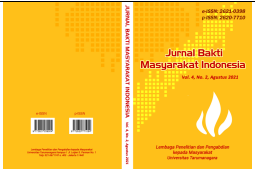EDUKASI PADA MASYARAKAT MENGENAI PERAN MIKROORGANISME DALAM PERUBAHAN IKLIM
Main Article Content
Abstract
Climate change is a hot topic and attracts great attention because it causes a series of side effects for the environment and living organisms in the world. Microorganisms are involved in many processes in nature that can affect climate change, including the complex cycle of phosphorus, sulfur, nitrogen, oxygen, and carbon. Microorganisms also play a role in producing and reducing greenhouse gases such as carbon dioxide and methane. In addition, microorganisms can respond positively or negatively to temperature. Understanding the activity of microorganisms is very important to know their functions and uses in the development of technologies that can combat climate change itself. Currently, the general public does not yet know the functions and uses of microorganisms to combat climate change. In collaboration with the American Society for Microbiology and Nutrienvisus Technologies, the Faculty of Biology, Atma Jaya Catholic University of Indonesia, conducts community service activities through online seminars on the role of microorganisms in climate change. Seminars are held online using the Zoom conference app. The participants in this activity were 210 people, including twenty-three high school students, seventy-six students, one housewife, seventy-two lecturers, four private employees, fourteen civil servants, and ten researchers. The forms of activities carried out were the presentation of the material, question and answer sessions, and the provision of questionnaires to the participants before and after the presentation of the material. The materials given are Soil Microbiomes and Climate Changes and Bacterial Ice Nucleation, and Air Microbiology. Speakers provide material based on the literature and the results of research that has been done. Questionnaires were administered online using the Mentimeter and Kahoot apps. The questionnaire results showed an increase in participants' understanding of the role of microorganisms in climate change
ABSTRAK:
Perubahan iklim menjadi topik yang menarik perhatian yang besar karena menyebabkan serangkaian efek samping bagi lingkungan maupun organisme hidup di dunia. Mikroorganisme terlibat pada banyak proses di alam yang dapat mempengaruhi perubahan iklim antara lain siklus kompleks fosfor, sulfur, nitrogen, oksigen dan karbon. Mikrooganisme juga berperan dalam menghasilkan dan mengurangi gas rumah kaca seperti karbon dioksida dan metana. Selain itu, mikroorganisme dapat memberikan respon positif maupun negatif terhadap suhu. Memahami aktivitas mikrooganisme sangat penting untuk mengetahui fungsi dan kegunaan dalam pengembangan teknologi yang dapat memerangi perubahan iklim itu sendiri. Saat ini, masyarakat umum belum mengetahui fungsi dan kegunaan mikroorganisme sebagai teknologi dalam memerangi perubahan iklim. Bekerja sama dengan American Society for Microbiology dan Nutrienvisus Technologies, Fakultas Teknobiologi Universitas Katolik Indonesia Atma Jaya melakukan kegiatan pengabdian masyarakat (PKM) melalui seminar secara daring mengenai peran mikroorganisme dengan perubahan iklim. Seminar diadakan secara daring menggunakan aplikasi konferensi Zoom. Peserta yang mengikuti kegiatan ini sejumlah 210 orang meliputi 23 orang siswa SMA, 76 orang mahasiswa, 1 orang ibu rumah tangga, 72 orang dosen, 4 orang karyawan swasta, 14 orang PNS, dan 10 orang peneliti. Bentuk kegiatan yang dilakukan adalah pemaparan materi, sesi tanya jawab, dan pemberian kuesioner kepada para peserta sebelum dan sesudah pemaparan materi. Materi yang diberikan adalah Soil Microbiomes and Climate Changes dan Bacterial Ice Nucleation and Air Microbiology. Pembicara memberikan materi berdasarkan literatur dan hasil penelitian yang telah dilakukannya. Kuesioner diberikan secara daring menggunakan aplikasi Mentimeter dan Kahoot. Hasil kuesioner menunjukkan terjadi peningkatan pemahaman peserta terhadap peran mikroorganisme terhadap perubahan iklim
Article Details
This work is licensed under a Jurnal Bakti Masyarakat Indonesia https://creativecommons.org/licenses/by-nc-sa/4.0/
References
Burdass, D., & Hurst, J. (2017). Microbes and climate change. Society for General Microbiology, 1(March 2016), 1–8. https://www.asm.org/images/Colloquia-report/FAQ-Microbes-and-Climate-change-web.pdf
Cavicchioli, R., Ripple, W. J., Timmis, K. N., Azam, F., Bakken, L. R., Baylis, M., Behrenfeld, M. J., Boetius, A., Boyd, P. W., Classen, A. T., Crowther, T. W., Danovaro, R., Foreman, C. M., Huisman, J., Hutchins, D. A., Jansson, J. K., Karl, D. M., Koskella, B., Mark Welch, D. B., … Webster, N. S. (2019). Scientists’ warning to humanity: microorganisms and climate change. Nature Reviews Microbiology, 17(9), 569–586. https://doi.org/10.1038/s41579-019-0222-5
Flemming, H. C., & Wuertz, S. (2019). Bacteria and archaea on Earth and their abundance in biofilms. Nature Reviews Microbiology, 17(4), 247–260. https://doi.org/10.1038/s41579-019-0158-9
Heald, C. L., Henze, D. K., Horowitz, L. W., Feddema, J., Lamarque, J.-F., Guenther, A., Hess, P. G., Vitt, F., Seinfeld, J. H.,
Goldstein, A. H., & Fung, I. (2008). Predicted change in global secondary organic aerosol concentrations in response to future climate, emissions, and land use change. Journal of Geophysical Research: Atmospheres, 113(D5), n/a-n/a. https://doi.org/10.1029/2007JD009092
Ledley, T. S., Sundquist, E. T., Schwartz, S. E., Hall, D. K., Fellows, J. D., & Killeen, T. L. (1999). Climate change and greenhouse gases. Eos, Transactions American Geophysical Union, 80(39), 453–458. https://doi.org/10.1029/99EO00325
Li, Q., Yan, Q., Chen, J., He, Y., Wang, J., Zhang, H., Yu, Z., & Li, L. (2012). Molecular Characterization of an Ice Nucleation Protein Variant (InaQ) from Pseudomonas syringae and the Analysis of Its Transmembrane Transport Activity in Escherichia coli. International Journal of Biological Sciences, 8(8), 1097–1108. https://doi.org/10.7150/ijbs.4524
Pepper, I. L., & Gerba, C. P. (2015). Aeromicrobiology. In Environmental Microbiology (pp. 89–110). Elsevier. https://doi.org/10.1016/B978-0-12-394626-3.00005-3
Ripple, W. J., Wolf, C., Newsome, T. M., Galetti, M., Alamgir, M., Crist, E., Mahmoud, M. I., & Laurance, W. F. (2017). World scientists’ warning to humanity: A second notice. BioScience, 67(12), 1026–1028. https://doi.org/10.1093/biosci/bix125



